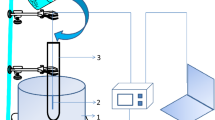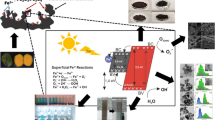Abstract
The effects of the addition of mango residue on the combustion of iron nitrate–urea mixtures are presented herein. The process was performed considering two systems: open (porcelain capsule) and closed (round-bottom flask), both with and without the addition of the residue, thus resulting in four different products. Thermogravimetric techniques (thermogravimetric analysis and differential thermal analysis) were used to assess the thermal behavior of the precursors, X-ray diffraction, Mossbauer spectroscopy and spectrometry in the infrared region with Fourier transform to analyze the influence of the synthesis parameters on the structure of the products, scanning electron microscopy, surface area, and porosity analysis, to analyze the morphology and textural properties of the samples. The addition of mango residue to either system caused changes in the combustion process, iron oxide phase, morphology, textural properties, and, particularly, the specific surface area in the closed system-produced material, in which a significant increase was observed. Thus, the addition of mango residue in the combustion synthesis of iron oxides can increase the added value of waste materials, thereby producing favorable economic and environmental impacts.






Similar content being viewed by others
References
Souza MOdG, Quadro EB, Rangel MdC. Propriedades texturais e catalíticas de Óxido de ferro contendo Cromo e Cobre. Quim Nova. 1998;21:428–33
Oliveira LCA, Fabris JD, Pereira MC. Óxidos de ferro e suas aplicações em processos catalíticos: Uma revisão. Quim Nova. 2013;36:123–30.
dos Santos Monteiro D, da Guarda Souza MO. Thermal decomposition of precursors and iron oxide properties. J Therm Anal Calorim. 2016. Springer Netherlands;123:955–63. Retrieved from: https://doi.org/10.1007/s10973-015-4840-5
Aali H, Mollazadeh S, Khaki JV. Single-phase magnetite with high saturation magnetization synthesized via modified solution combustion synthesis procedure. Ceram Int. Elsevier Ltd and Techna Group S.r.l. 2018;44:20267–74. Retrieved from: https://linkinghub.elsevier.com/retrieve/pii/S0272884218320698
Li Y, Lu H, Wang Y, Zhao Y, Li X 2019 Efficient removal of methyl blue from aqueous solution by using poly(4-vinylpyridine)–graphene oxide–Fe3O4 magnetic nanocomposites. J Mater Sci. 54: 7603–16. https://doi.org/10.1007/s10853-019-03441-8
Pereira da Silva C, Oliveira da Guarda Souza M, Lopes Dos Santos WN, Oliveira Bastos Silva L. Optimization of the production parameters of composites from sugarcane bagasse and iron salts for use in dye adsorption. Sci World J. 2019;2019:1–12. Retrieved from: https://www.hindawi.com/journals/tswj/2019/8173429/
Wen Y, Zhao Y, Guo M, Xu Y. Synergetic effect of Fe2O3 and BiVO4 as photocatalyst nanocomposites for improved photo-Fenton catalytic activity. J Mater Sci. 2019. US: Springer;54:8236–46. https://doi.org/10.1007/s10853-019-03511-x
Silva MF, Pineda EAG, Bergamasco R. Aplicação de óxidos de ferro nanoestruturados como adsorventes e fotocatalisadores na remoção de poluentes de águas residuais. Quim Nova. 2015;38:393–8.
Mourão HAJL, de Mendonça VR, Malagutti AR, Ribeiro C, Mendonça H de; ARM; CR, Mendonça HAJLMVR de; ARM; CR. Nanoestruturas em fotocatálise: uma revisão sobre estratégias de síntese de fotocatalisadores em escala nanométrica. Quim Nova. 2009;32:2181–90
Pang YL, Lim S, Ong HC, Chong WT. Research progress on iron oxide-based magnetic materials: Synthesis techniques and photocatalytic applications. Ceram Int. 2016. Elsevier;42:9–34. https://doi.org/10.1016/j.ceramint.2015.08.144
Radpour M, Masoudpanah SM, Alamolhoda S. Microwave-assisted solution combustion synthesis of Fe3O4 powders. Ceram Int. 2017;43:14756–62. Retrieved from: https://linkinghub.elsevier.com/retrieve/pii/S027288421731667X
Radpour M, Alamolhoda S, Masoudpanah SM. Effects of pH value on the microstructure and magnetic properties of solution combusted Fe3O4 powders. Ceram Int. 2017;43:13729–34. Retrieved from: https://linkinghub.elsevier.com/retrieve/pii/S0272884217315171
Mukasyan AS, Rogachev AS, Varma A. Mechanisms of reaction wave propagation during combustion synthesis of advanced materials. Chem Engeneering Sci. 1999;54:3357–67.
Varma A, Mukasyan AS, Rogachev AS, Manukyan KV. Solution combustion synthesis of nanoscale materials. Chem Rev. 2016;116:14493–586. Retrieved from: https://doi.org/10.1021/acs.chemrev.6b00279
Jain SR, Adiga KC, Pai Verneker VR. A new approach to thermochemical calculations of condensed fuel-oxidizer mixtures. Combust Flame. 1981;40:71–9. Retrieved from: http://linkinghub.elsevier.com/retrieve/pii/0010218081901115
Adams RA, Pol VG, Varma A. Tailored solution combustion synthesis of high performance ZnCo2O4 anode materials for lithium-ion batteries. Ind Eng Chem Res. 2017;56:7173–83.
Toniolo J, Takimi AS, Andrade MJ, Bonadiman R, Bergmann CP. Synthesis by the solution combustion process and magnetic properties of iron oxide (Fe3O4 and α-Fe2O3) particles. J Mater Sci. 2007;42:4785–91. Retrieved from: https://doi.org/10.1007/s10853-006-0763-7
Fathi H, Masoudpanah SMM, Alamolhoda S, Parnianfar H. Effect of fuel type on the microstructure and magnetic properties of solution combusted Fe3O4 powders S.r.l.. Ceramics International. 2017;43:7448–53. https://doi.org/10.1016/j.ceramint.2017.03.017
Wang X, Qin M, Fang F, Jia B, Wu H, Qu X, et al. Solution combustion synthesis of nanostructured iron oxides with controllable morphology, composition and electrochemical performance S.r.l.. Ceramics International. 2018;44:4237–47. https://doi.org/10.1016/j.ceramint.2017.12.004
Deshpande K, Mukasyan A, Varma A. Direct Synthesis of Iron Oxide Nanopowders by the Combustion Approach: Reaction Mechanism and Properties. Chem. Mater. 2004; 16; 4896–4904. https://doi.org/10.1021/cm040061m
Carvalho MS, Virgens CF. Effect of alkaline treatment on the fruit peel of Pachira aquatic Aubl.: Physico-chemical evaluation and characterization. Microchem J. 2018. Elsevier BV;143:410–5. https://doi.org/10.1016/j.microc.2018.08.021
Castro JDS, das Virgens CF. Thermal decomposition of Nephelium lappaceum L. peel. J Therm Anal Calorim. 2019;138, 3541–9. Retrieved from: https://doi.org/10.1007/s10973-019-08289-3
da Silva CP, dos Santos AV, Oliveira AS, Souza MO da G. Synthesis of composites and study of the thermal behavior of sugarcane bagasse/iron nitrate mixtures in different proportions. J Therm Anal Calorim. 2017;131:611–20
da Guarda Souza MO, Rebouças LM, de Castro LMF. Characterization and thermal decomposition study of mango residue biomass (Mangifera indica L.). J Therm Anal Calorim. 2019. Springer International Publishing;139:1811–6. Retrieved from: https://doi.org/10.1007/s10973-019-08540-x
Sauthier MCda S, da Silva EGP, Santos BRda S, Silva EFR, Caldas Jda C, Minho LAC, et al. Screening of Mangifera indica L. functional content using PCA and neural networks (ANN). Food Chem. 2018. Elsevier:0–1. https://doi.org/10.1016/j.foodchem.2018.01.129
Yingkamhaeng N, Sukyai P. The potential of mango peel utilization for cellulose extraction by hydrothermal pretreatment. 26th Annu Meet Thai Soc Biotechnol Int Conf.; 2014. p. 101–9
Ganeshan G, Shadangi KP, Mohanty K. Thermo-chemical conversion of mango seed kernel and shell to value added products. J Anal Appl Pyrol. 2016. Elsevier BV;121:403–8. https://doi.org/10.1016/j.jaap.2016.09.004
Mihoc G, Ianoş R, Păcurariu C, Lazău I. Combustion synthesis of some iron oxides used as adsorbents for phenol and p-chlorophenol removal from wastewater. J Therm Anal Calorim. 2013;112:391–7. Retrieved from: https://doi.org/10.1007/s10973-012-2750-3
Raheem A, Dupont V, Channa AQ, Zhao X, Vuppaladadiyam AK, Taufiq-Yap Y et al. Parametric characterization of air gasification of Chlorella vulgaris biomass. Energy Fuels. 2017. American Chemical Society;31, 3:2959–69. https://doi.org/10.1021/acs.energyfuels.6b03468
Carp O, Patron L, Diamandescu L, Reller A. Thermal decomposition study of the coordination compound [Fe(urea)6](no3)3. Thermochim Acta. 2002;390:169–77. Retrieved from: http://linkinghub.elsevier.com/retrieve/pii/S0040603102000850
Asuha S, Zhao S, Jin XH, Hai MM, Bao HP. Effects of synthetic routes of Fe–urea complex on the synthesis of γ-Fe2O3 nanopowder. Appl Surf Sci. 2009;255:8897–901. Retrieved from: http://linkinghub.elsevier.com/retrieve/pii/S0169433209008873
Asuha S, Suyala B, Siqintana X, Zhao S. Direct synthesis of Fe3O4 nanopowder by thermal decomposition of Fe–urea complex and its properties. J Alloys Compd. 2011. Elsevier BV;509:2870–3. https://doi.org/10.1016/j.jallcom.2010.11.145
Deshpande K, Mukasyan A, Varma A. Direct synthesis of iron oxide nanopowders by the combustion approach: Reaction mechanism and properties. Chem Mater. 2004;16:4896–904.
Cunha IT, Teixeira IF, Mesquita JP, Ardisson JD, Binatti I, Pereira FV, et al. Cellulose nanocrystals assembled on the Fe 3O 4 surface as precursor to prepare interfaced C/Fe3O4 composites for the oxidation of aqueous sulfide. J Braz Chem Soc. 2015;27:363–71. Retrieved from: https://doi.org/10.5935/0103-5053.20150283
da Guarda Souza MO, dos Santos MVR, Castro LMF, da Silva CP. Production and in situ transformation of hematite into magnetite from the thermal decomposition of iron nitrate or goethite mixed with biomass. J Therm Anal Calorim. 2020;139(3):1731–9.
Ueki Y, Yoshiie R, Naruse I, Ohno K, Maeda T, Nishioka K, et al. Reaction behavior during heating biomass materials and iron oxide composites. Fuel. 2013. Elsevier Ltd;104:58–61. https://doi.org/10.1016/j.fuel.2010.09.019
Ianoş R, Păcurariu C, Muntean SG, Muntean E, Nistor MA, Nižňanský D. Combustion synthesis of iron oxide/carbon nanocomposites, efficient adsorbents for anionic and cationic dyes removal from wastewaters. J Alloys Compd. 2018;741:1235–46. Retrieved from: https://linkinghub.elsevier.com/retrieve/pii/S0925838818302470
Darezereshki E, Bakhtiari F, Alizadeh M, Behrad vakylabad A, Ranjbar M. Direct thermal decomposition synthesis and characterization of hematite (α-Fe2O3) nanoparticles. Mater Sci Semicond Process. 2012. Elsevier;15:91–7. https://doi.org/10.1016/j.mssp.2011.09.009
Păcurariu C, Paşka O, Ianoş R, Muntean SG. Effective removal of methylene blue from aqueous solution using a new magnetic iron oxide nanosorbent prepared by combustion synthesis. Clean Techn Environ Policy. 2016;18:705–15. Retrieved from: http://www.scopus.com/inward/record.url?eid=2-s2.0-84960426231&partnerID=tZOtx3y1
Lima SB, Borges SMS, Rangel MdC, Marchetti SG. Effect of iron content on the catalytic properties of activated carbon-supported magnetite derived from biomass. J Braz Chem Soc. 2013;24:344–54
Carvalho MD, Henriques F, Ferreira LP, Godinho M, Cruz MM. Iron oxide nanoparticles: The Influence of synthesis method and size on composition and magnetic properties. J Solid State Chem. 2013. Elsevier;201:144–52. https://doi.org/10.1016/j.jssc.2013.02.024
Tyapkin PY, Petrov SA, Chernyshev AP, Larichev YV, Kirik SD, Gribov PA, et al. Properties of iron oxides inserted into SBA-15 mesoporous silica. Mater Today Proc. 2017. Elsevier Ltd;4:11392–5. https://doi.org/10.1016/j.matpr.2017.09.015
Kudo S, Sugiyama K, Norinaga K, Li C-ZZ, Akiyama T, Hayashi JI. Coproduction of clean syngas and iron from woody biomass and natural goethite ore. Fuel. 2013. Elsevier Ltd;103:64–72. https://doi.org/10.1016/j.fuel.2011.06.074
Acknowledgements
The authors would like to thank the Applied Chemistry Postgraduate Program (PGQA) of Universidade do Estado da Bahia (UNEB) for the granted infrastructure and Higher Education Personnel Improvement Coordination (Capes) for their financial support. We would like to thank Editage (www.editage.com) for English language editing.
Author information
Authors and Affiliations
Corresponding author
Additional information
Publisher's Note
Springer Nature remains neutral with regard to jurisdictional claims in published maps and institutional affiliations.
Supplementary Information
Below is the link to the electronic supplementary material.
Rights and permissions
About this article
Cite this article
Ferreira de Castro, L.M., da Guarda Souza, M.O. Effects of the addition of mango residue on solution combustion synthesis of iron oxides. J Therm Anal Calorim 147, 7183–7191 (2022). https://doi.org/10.1007/s10973-021-11031-7
Received:
Accepted:
Published:
Issue Date:
DOI: https://doi.org/10.1007/s10973-021-11031-7




